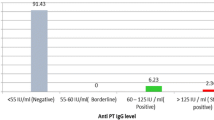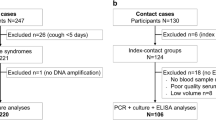Abstract
Pertussis in healthcare workers is of particular concern, as they can be in contact with infected patients and may transmit the infection to susceptible patients, co-workers and other contacts. This study was carried out to examine the prevalence of pertussis antibodies in hospital personnel. A total of 487 healthcare workers ≥25 years in age and students (19–24 years) in hospital training were recruited. The overall prevalence of pertussis antibody determined by ELISA was 51.7%. No significant differences on prevalence by age group (19–24, 25–34, 35–44 and ≥45 years) and occupation (student, physician, nursing personnel and non-healthcare occupations) were found. In Spain, health care personnel in a general hospital will not have a significantly higher risk of serologically detectable contact with B. pertussis. Fifty percent of physicians and nursing personnel working in hospital were seronegative for pertussis antibody. A high percentage of these subjects will be susceptible to infection.
Similar content being viewed by others
References
Instituto de Salud Carlos III. Ministerio de Sanidad y Consumo. Incidencia de las enfermedades transmisibles de declaración obligatoria. Casos y tasas por 100.000 habitantes a nivel provincial/CC.AA. España, 2000. Bol Epidemiol Sem 2001; 10: 106-107.
Cherry JD, Brunnell PA, Golden GS, Karzon DT. Report of the Task Force on pertussis and pertussis immunization. Pediatrics 1988; 81(Suppl): 939-984.
Jenkinson D. Duration of effectiveness of pertussis vaccine: Evidence from a 10 year community study. Br Med J 1988; 296: 612-614.
Cristie CDC, Marx ML, Marchant CD, Reising SF. The 1993 epidemic of pertussis in Cincinnati: Resurgence of disease in a highly immunized population of children. N Engl J Med 1994; 331: 16-21.
Mortimer EA. Pertussis and its prevention: A family affair. J Infect Dis 1990; 161: 473-479.
Aoyama T, Takeuchi Y, Goto A, et al. Pertussis in adults. Am J Dis Child 1992; 146: 163-616.
Mertsola J, Ruuskanen O, Eerola E, et al. Intrafamiliar spread of pertussis. J Pediatr 1983; 103: 359-363.
Nelson JD. The changing epidemiology of pertussis in young infants: The role of reservoirs of infection. Am J Dis Child 1978; 132: 371-373.
Christie CD, Baltimore RS. Pertussis in neonates. Am J Dis Child 1989; 143: 1199-1202.
Kurt TL, Yeager AS, Suenette S, Dunlop S. Spread of pertussis by hospital staff. JAMA 1972; 221: 264-267.
Linneman CC, Ramundo N, Perlstein PH. Use of pertussis vaccine in an epidemic involving hospital staff. Lancet 1975; 2: 540-543.
Steketee RW, Wassilak SGF, Adkins WN, et al. Evidence for a high attack rate and efficacy of erythromycin prophylaxis in a pertussis outbreak in a facility for the developmentally disabled. J Infect Dis 1988; 157: 434-440.
Addiss DG, Davis JP, Meade BD, et al. A pertussis outbreak in Wisconsin nursing home. J Infect Dis 1991; 164: 704-710.
Tanaka Y, Fujinaga K, Goto A, et al. Outbreak of pertussis in a residential facility for handicapped people. Dev Biol Stand 1991; 73: 329-332.
Christie CDC, Glover AM, Willke MJ, Marx ML, Reising SF, Hutchinson NM. Containment of pertussis in the regional pediatric hospital during the Greater Cincinnati epidemic of 1993. Infect Control Hosp Epidemiol 1995; 16: 556-563.
Doebbeling BN, Feilmeier ML, Herwaldt LA. Pertussis in adult male infected with the human immunodefi-ciency virus. J Infect Dis 1990; 161: 1296-1298.
Ng VL, York M, Hadley WK. Unexpected isolation of Bordetella pertussis from patients with acquired immunodeficiency virus. J Clin Microbiol 1989; 27: 337-338.
Edwards KM, Decker MD, Graham BS, Mezzatesta J, Scott J, Hackell J. Adult immunization with a cellular pertussis vaccine. JAMA 1993; 269: 53-56.
Shefer A, Dales L, Nelson M, Werner B, Baron R, Jackson R. Adult immunization with acellular pertussis vaccine among hospital staff during an outbreak of pertussis. J Infect Dis 1995; 171: 1053-1056.
Ortega P, Gil A, Astasio P, et al. Prevalencia de anticuerpos frente a tétanos, difteria y Bordetella pertussis en profesionales sanitarios. Enferm Infecc Microbiol Clin 1999; 17: 135-137.
Astasio P, Gil A, Ortega P, Martínez D, Domínguez V, González A. Seroprevalencia de anticuerpos frente a tétanos, difteria y Bordetella pertussis en una población de adultos jóvenes. Vacunas 2000; 1: 7-9.
Koster K, Riffelmann M, Dohrn B, Wirsing von Konig CH. Comparison of five commercial Enzyme-Linked Immunosorbent Assays for detection of antibodies to Bordetella pertussis. Clin Diagn Lab Immunol 2000; 3: 422-427.
García-Corbeira P, Dal-Ré R, Aguilar L, García-de-Lomas J. Seroepidemiology of Bordetella pertussis infections in the Spanish population: A cross-sectional study. Vaccine 2000; 18: 2173-2176.
Mink CM, Sirota NM, Nugent S. Outbreak of pertussis in a fully immunized adolescent and adult population. Arch Pediatr Adolesc Med 1994; 148: 153-157.
Senzilet LD, Halperin SA, Spike JS, et al. Pertussis is a frequent cause of prolonged cough illness in adults and adolescents. Clin Infect Dis 2001; 32: 1691-1697.
Nenning ME, Shinefield HR, Edwards KM, Black SB, Fireman BH. Prevalence and incidence of adult pertussis in an urban population. JAMA 1996; 275: 1672-1674.
Wright SW, Decker MD, Edwards KM. Incidence of pertussis infection in healthcare workers. Infect Control Hosp Epidemiol 1999; 20: 120-123.
Edwards KM. Is pertussis a frequent cause of cough in adolescents and adults? Should routine pertussis immunization be recommended? Clin Infect Dis 2001; 32: 1698-1699.
Author information
Authors and Affiliations
Rights and permissions
About this article
Cite this article
de Juanes, JR., Gil, A., González, A. et al. Seroprevalence of pertussis antibody among health care personnel in Spain. Eur J Epidemiol 19, 69–72 (2004). https://doi.org/10.1023/B:EJEP.0000013270.63515.e6
Issue Date:
DOI: https://doi.org/10.1023/B:EJEP.0000013270.63515.e6




